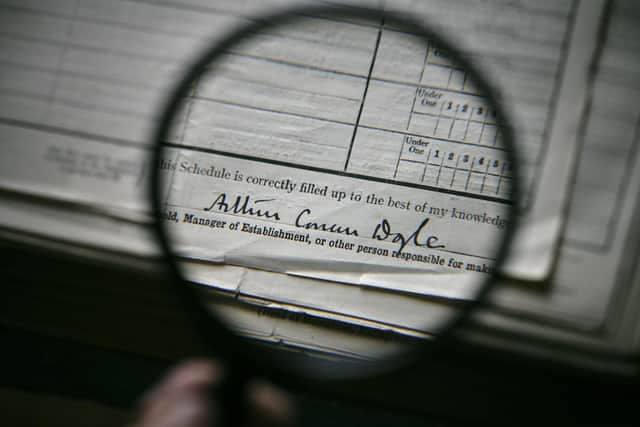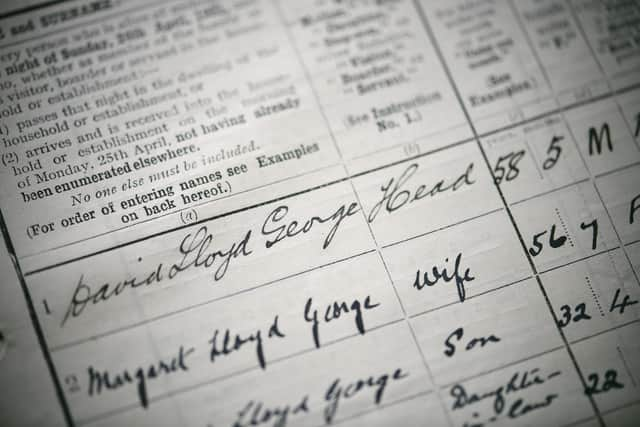1921 census revealed: Archive gives glimpse into lives of famous faces including Sir Captain Tom Moore - who was just one-year-old
The lives of every man, woman and child living in England and Wales in 1921 have been revealed like never before, with detailed census returns from Windsor Castle and Chequers to cramped family homes made available to the public for the first time.
The records, released after 100 years locked in the vaults, offer an unprecedented snapshot of life across the two nations, capturing the personal details of 38 million people on June 19 1921.
Advertisement
Hide AdAdvertisement
Hide AdThe century-old document contains mention of a certain Thomas Moore, better known now as “Captain Tom”, who would go on to become one of the totems of the nation’s stoicism during the coronavirus pandemic by raising more than £30 million for the NHS through walking lengths of his garden.


But back in 1921, Captain Sir Tom would have unlikely been able to accomplish a few strides of the feat that would seal him a place in the nation’s hearts.
Young master Moore, of Keighley in Yorkshire, was just a year and one month old when the census was completed.
He is listed as the son of Wilfred, a 36-year-old building contractor, and 34-year-old Isabel, whose occupation was listed as “household duties”.
Advertisement
Hide AdAdvertisement
Hide AdThe family, complete with young Thomas’s four-year-old sister Freda, lived in a six-bedroom property at the time the census was completed.


While Captain Tom’s name would have been unremarkable to census officials, others contained within the returns would certainly have stood out among the millions of records.
None more so than David Lloyd George, prime minister during the latter stages of the First World War, who spent June 19 1921 – when the census was recorded – at Chequers along with his wife, Margaret, son Richard and his family.
The statesman records his personal occupation as “Prime Minister”, his employment being “His Majesty’s Government”, and his place of work as “10 Downing Street”.
Advertisement
Hide AdAdvertisement
Hide AdAside from the six family members inside the Buckinghamshire residence, the census also lists three civil servants as being present, including his private secretary Edward William Macleay Grigg, as well as 13 servants – the youngest being a 15-year-old kitchen maid called Lavinia originally from Hadfield in Derbyshire.
The form, which shows there were eight males and 17 females present, was filled out by Lloyd George himself.
Another famous name contained within the pages was Sir Arthur Conan Doyle, creator of detective series Sherlock Holmes.
He counted three overnight visitors to his home when the census was taken, prompting suggestions from historians that the known paranormal investigator may have been taking part in a seance – a ceremony conducted to make contact with the dead.
Advertisement
Hide AdAdvertisement
Hide AdRecords show the 62-year-old author was joined by Jean, his 40-year-old wife, and their three children Denis, Malcolm and Jean junior, aged 12, 10 and eight, respectively, as well as five female servants.
But there were also three guests present – married couple James Hewat McKenzie and Barbara McKenzie, 54 and 51, and 30-year-old “spinster” entered into the census by Conan Doyle as “Ada Bassinet” from “Toledo, USA”.
It is believed this was in fact Ada Besinnet, a known American medium, while Mr McKenzie was a parapsychologist who founded the British College of Psychic Science.
Another author, Beatrix Potter, had a long-established career as a writer of children’s stories following the success of The Tale Of Peter Rabbit in the early 1900s.
Advertisement
Hide AdAdvertisement
Hide AdBut it was another profession – and her married name, rather than her pen name – that appeared on the 1921 census.
Helen Beatrix Heelis, the 54-year-old wife of solicitor William Heelis, was described as a “farmer” due to her passion for sheep breeding and conservation at her home in the Lake District.
Meanwhile, Nancy Astor, Britain’s first female MP, was one of more than 25 people at her home on the night of the census.
The Plymouth Sutton MP was present with her husband, Waldorf Astor, and their young sons Michael and John, as well as a string of visitors, including a niece and a cousin.
Advertisement
Hide AdAdvertisement
Hide AdAlso in attendance were Conservative colleagues Raymond Greene, the Hackney North MP, and Edward Winterton, the Horsham MP, as well as a 30-year-old American-born “Parliamentary candidate” called Sidney Herbert.
The Census also shines a light on the grim reality of post-First World War Britain, amid crippling unemployment and social unrest, a changing jobs market, and a shortage of suitable housing leaving whole families packed into one-bedroom properties.
Historian and broadcaster professor David Olusoga told the PA news agency: “I think it shows a snapshot of a country in absolute trauma, a country in the midst of trying to recover from what was the biggest rupture in its history.
“It captures one of the most dramatic and dangerous moments.”
Advertisement
Hide AdAdvertisement
Hide AdAmong those whose census return underlined the hardship suffered by the working classes was James Bartley, a father of three young children from Sussex, who wrote: “Stop talking about your homes for heroes and start building some houses and let them at a rent a working man can afford to pay.”
Retired Army officer Harold Orpen, 46, originally from London, apologised to census officials for providing a typed response rather than the required handwritten one, adding: “I lost half my right hand in the late war and cannot write properly.”
Alice Underwood, 53, from Buckinghamshire, was more forthright.
“What a wicked waste of taxpayers’ money at this time of unemployment,” she wrote.
Advertisement
Hide AdAdvertisement
Hide AdWhile basic details of the 1921 census were released shortly after its compilation, the digitised records offer the first glimpse at individual returns.
Audrey Collins, historian at the National Archives, said: “We can actually see at first-hand peoples’ quite heartfelt comments. You don’t protest about something if you’re just a little bit irritated; these are real cries from the heart.”
She added: “Undoubtedly, things were very, very grim for an awful lot of people in the 1920s.
“There were an awful lot of people out of work, and that didn’t really get better over the coming decade.
Advertisement
Hide AdAdvertisement
Hide Ad“So I think 1921 is very much a good survey of what the population was settling down to after the rigours of the First World War, but also it was the shape of things to come in the 1920s.”
The impact of the First World War is writ large across the millions of census pages, which genealogy website Findmypast and the National Archives have spent three years conserving and digitising.
The census reveals there were 1,096 women for every 1,000 men recorded, the highest discrepancy since the census began in 1801, and by 1951 was still 1,081 per 1,000 men.
This means that in 1921 there were around 1.7 million more women than men in England and Wales, the largest difference ever seen in a census, underlining the deadly significance of the First World War on men.
Advertisement
Hide AdAdvertisement
Hide AdIndeed the population grew by just 4.9% between 1911 and 1921, to 37.9 million, having previously seen a double-digit increase every decade since records began.
The 1921 census is more detailed than any previously undertaken, having asked people about their place of work, employer and industry for the first time, meaning high street names such as Sainsbury’s, Rolls-Royce and Selfridges appear on its pages.
Unlike previous years, people were also able to declare their marital status as “divorced”, with more than 16,000 people doing so.
However, this figure is expected to be much lower than the actual number due to the stigma surrounding divorce at the time.
Advertisement
Hide AdAdvertisement
Hide AdMary McKee, Findmypast census expert, described the careful handling and digitisation of more than 18 million pages of census document as “three years of a labour of love”.
She added: “In terms of the national story, I think it’s going to be impressive what you can find in these records.
“But the other side of it is learning more about our own unique family stories and those individual stories that are found in each individual document.”
The census has been completed every 10 years since 1801, although documents are legally required to remain secret for 100 years.
Advertisement
Hide AdAdvertisement
Hide AdThe 1921 data proved even more significant given the 1931 returns were destroyed in a fire at a storage unit, while the 1941 census was abandoned due to the continuing Second World War.
The most recent census for England and Wales was sent to households in March last year.
The 1921 census is available online at findmypast.co.uk as well as in person at the National Archives in Kew, the National Library of Wales in Aberystwyth and the Manchester Central Library.
